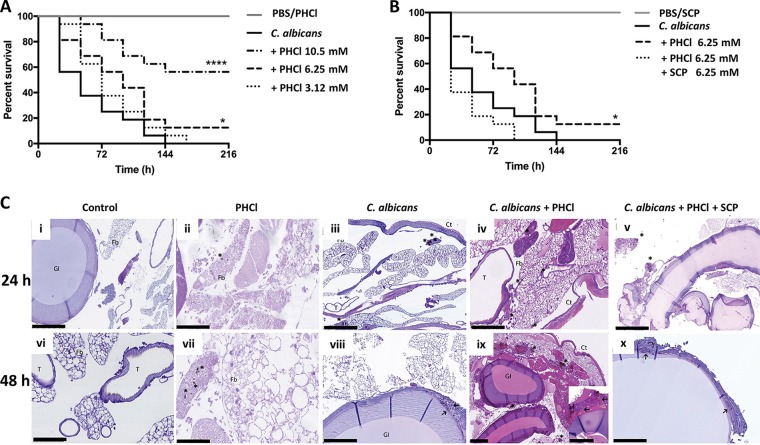FIG 4.
Pilocarpine hydrochloride acts through muscarinic-like receptors to prolong survival of Candida albicans-infected Galleria mellonella by inhibiting biofilm formation and modulating host immunity in vivo. The effect of PHCl on the outcome of systemic candidiasis was investigated using a G. mellonella infection model. (A) A Kaplan-Meier plot shows the effects of different concentrations of PHCl on the survival of Candida albicans-infected larvae. The data are derived from three independent experiments with groups of 16 larvae (n = 48). ***, P < 0.001; *, P < 0.05, as determined by the log rank test in comparison to larvae inoculated with C. albicans alone. PBS alone and PHCl alone-injected larvae were used as controls and had no effect on larvae survival. (B) To verify specificity, C. albicans-infected larvae were also inoculated with PHCl and SCP in combination. The data are derived from three independent experiments with groups of 16 larvae (n = 48). *, P < 0.05, as determined by the log rank test in comparison to larvae inoculated with C. albicans. Larvae injected with PBS alone and SCP alone were used as controls, and PBS and SCP alone had no effect on larva survival. (C) Histological analysis of larvae was performed at 24 and 48 h postinoculation using hematoxylin and eosin (HE) and periodic acid-Schiff (PAS) staining. (i and vi; HE) (ii and vii; HE) larva inoculated with PHCl (6.25 mM) alone. (iii and viii; PAS) larvae infected with C. albicans. (iv and ix; HE) larvae infected with C. albicans in the presence of PHCl (6.25 mM). (v and x; PAS). Larvae infected with C. albicans in the presence of PHCl (6.25 mM) and SCP (6.25 mM). Asterisks highlight melanized nodules, whereas arrows show C. albicans cells and hyphae. Representative images are shown from histological analysis of two larvae for each condition from three independent experiments. Fb, fat body; Ct, cuticle; GI, gastrointestinal tract; T, trachea; Nd, nodule. Bars, 250 μm (panels i, v, and ix) and 100 μm (panels ii, iii, iv, vi, vii, viii, and x).

